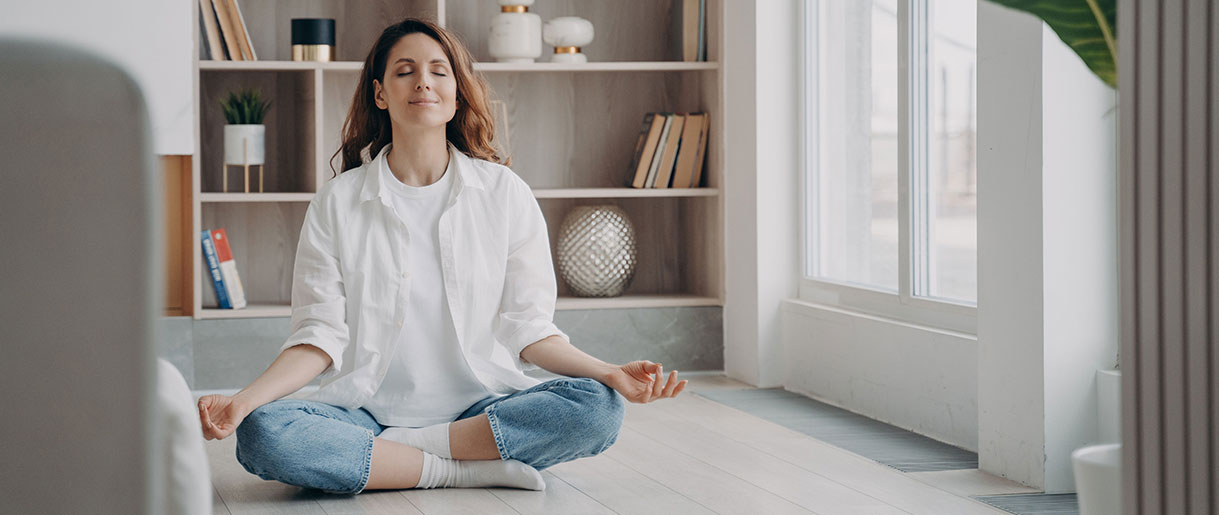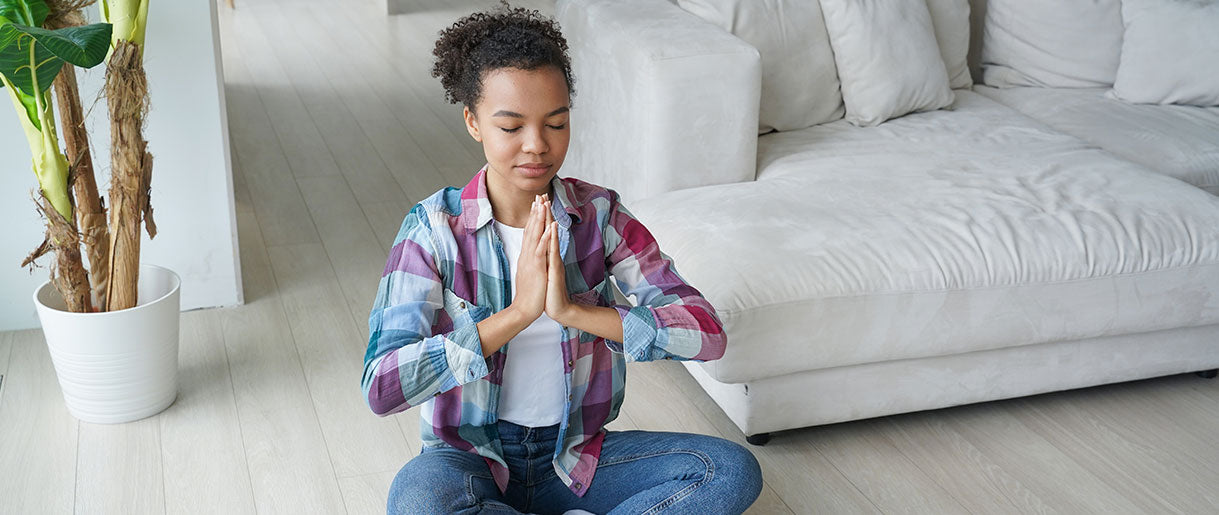Flow State Meditation is this fantastic blend where the calmness of meditation meets the supercharged focus of being 'in the flow.' It's like hitting that sweet spot where your mind is both completely at ease and razor-sharp focused.
Whether you're looking to boost your creativity, amp up your productivity, or find a deeper sense of mental peace, Flow State Meditation might be your ticket.
But here's the million-dollar question: How do you get there?
In this article, we will walk you through it step by step. Think of it as your guide to understanding flow meditation and how to slip into that state.
1. Create a Conducive Environment
Creating the right environment is like setting the stage for an excellent performance—in this case, your meditation. Here's why it matters and how to do it:
- Peaceful Surroundings: Choose a spot where you're least likely to be disturbed. It could be a cozy corner in your room, a quiet spot in your garden, or even a peaceful public park.
- Comfort is Key: Make sure you're comfortable. A meditation cushion, a comfy chair, or a soft mat can make a big difference. You don't want to be thinking about how much your back aches in the middle of your session!
Imagine walking into your meditation space and feeling a wave of calm wash over you. That's not just nice to have; it's crucial to getting into the flow state.
So, take a little time to create your meditation haven. It doesn't have to be fancy or 'Instagram-worthy'—it just needs to feel right for you. A few plants, soft lighting, or a gentle scent from a candle or diffuser can all add to the ambiance.
2. Set Clear Intentions

Setting clear intentions before you meditate is like drawing a map for your journey. It's about knowing where you're headed. Here's how to get it right:
- Define Your Purpose: Ask yourself, 'Why am I meditating today?' It could be to find calm, enhance creativity, or enjoy a few moments of peace—define the benefits of your morning meditation. Your intention sets the tone.
- Visualize Your Goal: Take a moment to visualize what achieving this intention looks and feels like. This mental imagery can be a powerful motivator and guide.
Think of it like choosing the destination for a road trip. You wouldn't just hop in your car and drive aimlessly, right? The same goes for meditation.
When you sit down to meditate, take a few deep breaths and declare your intention, either out loud or in your mind.
It could be something as simple as, 'I intend to focus deeply,' or 'I want to emerge from this session feeling refreshed.' Setting this intention is like planting a seed to guide your meditation experience.
3. Start with Deep Breathing
Beginning your meditation with deep breathing is like laying the foundation for a house. It's essential for building a strong and focused meditation practice. Here's the scoop on deep breathing:
- Calms the Mind:Deep breathing helps to calm your nervous system, setting a relaxed tone for your meditation. It's like telling your body, "Hey, it's time to chill."
- Enhances Focus: As you focus on your breath, you train your mind to concentrate. Focusing on each inhale and exhale can sharpen your attention, prepping you for more profound meditation.
Imagine your breath as a tool that harmonizes your mind and body. As you breathe in, feel the air filling you with calmness; as you breathe out, picture releasing any tension or stress.
To get started, find a comfortable rhythm. Breathe in slowly through your nose, let your chest and belly expand, and then exhale gently through your mouth or nose. You don't have to force it—just nice, easy breaths.
4. Focus on the Present Moment

Focusing on the present moment is like tuning your radio to the perfect station—where everything comes in clear. Here's why it's a crucial step in your meditation journey:
- Ditching Distractions: By centering your mind on the 'now,' you're less likely to be sidetracked by random thoughts or external noises. It's about being here, in this very moment.
- Building Awareness: Concentrating and focusing on the present helps you develop a deeper awareness of your body, breath, and surroundings, which is essential for reaching a flow state.
Think of the present moment as your anchor. It's easy to drift away into thoughts about the past or worries about the future. But you're strengthening your mindfulness muscle every time you bring your focus back to the present—to your breath, the sensation of sitting, the sounds around you.
To practice this, try a simple exercise: notice five things you can see, four things you can touch, three things you can hear, two things you can smell, and one thing you can taste. This technique can help bring your attention back to the here and now.
5. Gradually Deepen Your Meditation
Gradually deepening your meditation is like slowly descending into a clear, tranquil pool. It's about easing into a deeper state of consciousness. Here's how you can do it:
- Step-by-Step Approach: Start with focusing on your breath or a simple mantra. As you get more comfortable, slowly expand your focus to include more elements of your mind and body.
- Allow Natural Progression: Don't rush or force it. Let your mind and body naturally lead you deeper. It's like drifting gently down a river, letting the current take you.
Think of each meditation session as a journey. You start at the surface, and as you relax and focus, you naturally sink deeper. The deeper you go, the less you feel the outside noise.
You might try visualizing a place where you feel completely at peace to deepen your meditation. It could be a beach, a forest, or any space that resonates with you.
Imagine yourself in this place, exploring it with all your senses. This visualization can help transport your mind to a deeper, more tranquil state.
6. Be Open to the Experience

Being open to the experience in meditation is like opening the door to a new adventure. You never know what you might discover! Here's the significance of this openness:
- Letting Go of Expectations: Approach your meditation without preconceived notions or goals. It's not about achieving a specific state but experiencing whatever arises.
- Welcoming All Sensations: Whether it's peace, restlessness, joy, or something else, welcome each sensation and thought as a part of the experience. It's all valid.
Imagine your meditation practice as an exploration, not a destination. Each session is an opportunity to learn something new about yourself, whether pleasant or challenging.
To cultivate openness, remind yourself before each session that there's no 'right' or 'wrong' way to feel. Meditation can bring many experiences, and being open to them allows for a more genuine and enriching practice.
7. Incorporate Mindfulness Practices
Incorporating mindfulness into your meditation is like adding seasoning to a meal—it enhances the whole experience. Mindfulness is all about staying aware and present. Here's how it enriches your meditation:
- Staying Grounded: Mindfulness keeps you anchored in the present moment. It's about observing your thoughts and sensations without getting swept away by them.
- Enhanced Focus: By continually bringing your attention back to the present, mindfulness increases your ability to focus, which is crucial for deepening your meditation.
Imagine your thoughts like clouds in the sky. Mindfulness allows you to observe them without getting caught in a storm. You notice them, acknowledge them, and then let them drift away.
To practice mindfulness, try focusing on your breath, the sensations in your body, or the sounds around you. Whenever your mind wanders—and it will—gently guide it back to your focus point.
8. Use Guided Imagery

Using guided imagery in meditation can be like following a story—it leads your mind to relaxation and focus. Here's how this imaginative practice can help:
- Engages the Mind: Guided imagery provides a narrative or scene for your mind to engage with, which can help maintain focus and deepen the meditative experience.
- Enhances Relaxation: Visualizing peaceful and calming images can significantly enhance the relaxation effect of meditation, making it easier to slip into a flow state.
Imagine you're on a guided tour through a lush forest or a serene beach in your mind. The power of guided imagery lies in its ability to transport you to a place of deep calm and focus, using the power of your imagination.
You might listen to a guided meditation recording to incorporate guided imagery or create your own mental landscape. Picture a scene in vivid detail—the sounds, the smells, the sights—and let yourself explore this space with your mind's eye.
9. Gradually Increase Duration
Just like with any exercise, gradually increasing the duration of your meditation sessions helps build your mental stamina and depth. Here's how extending your practice can enhance your experience:
- Strengthening Focus: The longer you meditate, the stronger your focus becomes. It's like training a muscle—the more you use it, the stronger it gets.
- Deepening the Experience: Longer sessions can lead to deeper states of meditation. Over time, you might find yourself slipping into the flow state more easily and frequently.
Think of it as a slow and steady journey into more profound meditation. You start with what feels comfortable—maybe just five minutes a day. Then, as you get more accustomed to the practice, you add a few more minutes each week.
To do this, listen to your mind and body. There's no rush or competition. It's about finding the right pace and gradually building from there.
10. Reflect Post-Meditation

Post-meditation reflection is like looking back at a journey you've just taken. It allows you to understand and appreciate your meditation experience more deeply. Here's why it's beneficial:
- Gaining Insights: Reflecting after meditation can provide insights into your mental patterns, reactions, and overall experience. It's like debriefing yourself—'What did I learn? How did I feel?'
- Enhancing Future Sessions: By understanding what works for you and what doesn't, you can tailor future meditation sessions to be more effective and fulfilling.
Imagine sitting quietly after your meditation, taking a few moments to ponder the experience. Did your mind wander? Did you feel moments of peace or frustration? What brought you back to focus?
To practice this, spend a few minutes after your meditation simply sitting in silence. You might journal your thoughts or just sit with them, observing and acknowledging them without judgment. This reflection is a powerful tool to deepen your understanding of your meditation practice and yourself.
FAQs About Flow State Meditation
Can Anyone Achieve A Flow State Through Meditation, Or Is It Limited To Experienced Practitioners?
Achieving a flow state through meditation is an accessible journey for everyone, regardless of experience level. While seasoned practitioners might find it easier to enter this state due to familiarity with meditative techniques, beginners can also experience flow by cultivating a practice suited to their comfort and skill level.
The key lies in consistent practice, creating an environment conducive to focus, and applying techniques that encourage complete immersion in the present activity. Over time, as one's proficiency in meditation increases, so does the ease of accessing the flow state.
How Long Does It Take To Reach A Flow State Through Meditation, And How Can I Tell If I'm In It?
The time it takes to reach a flow state through meditation varies widely from person to person, as it's influenced by individual mental states, the environment, and one's familiarity with the practice.
You may recognize you're in a flow state when you experience a sense of effortless concentration, deep enjoyment, and intrinsic motivation where time seems to vanish.
The most reliable approach to achieving this state more quickly is regular meditation practice, progressively deepening your focus and familiarity with the state of flow itself.
Can Flow-State Meditation Improve Overall Well-Being And Productivity, And If So, How?
Flow-state meditation can significantly enhance overall well-being and productivity. By fostering a deep sense of immersion and presence, individuals often experience heightened creativity, improved concentration, and reduced stress levels.
This state allows for a seamless blend of action and awareness, reducing mental clutter and creating a space where an individual can excel in a given task without the interference of counterproductive thoughts.
Over time, this practice promotes emotional resilience, enhances problem-solving abilities, and cultivates a sense of fulfillment and contentment in various aspects of life.
Key Takeaways
In the symphony of everyday life, finding our rhythm demands more than just going through the motions.
It's about transcending the ordinary, tapping into an inner expanse with extraordinary potential. Flow state meditation isn't merely a practice but a gateway to this uncharted territory of our limitless capabilities.
From the first golden hour of the morning to the waning moments of the evening, every second holds the promise of deeper engagement, clarity, and joy. By embracing the principles of flow state meditation, we're not just participants in life's grand orchestra; we become the maestros, skillfully navigating our destinies with poise and vigor.
Yet, the journey doesn't end here. This is a path of continuous exploration, and your experiences, insights, and reflections fuel this communal voyage.
How have you encountered flow in your life? What shifts have you noticed since you began meditating? Are there moments when you felt an unmistakable surge of creativity, and how did it transform your day?
Share your stories, insights, and questions in the comments below.










Let Us Know Your Comments